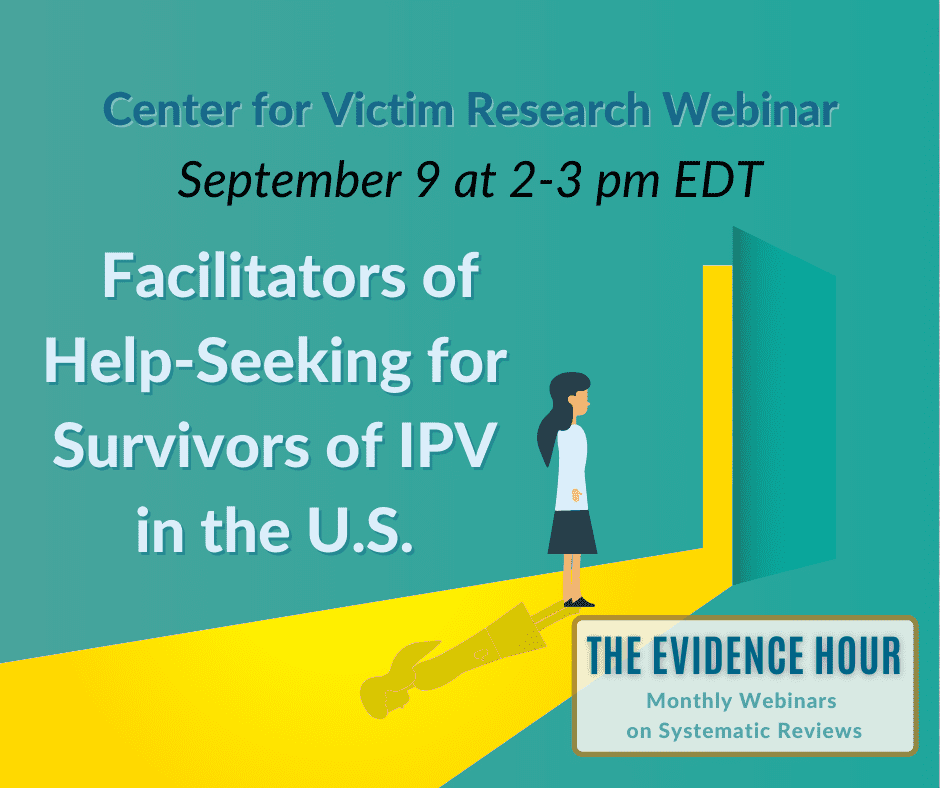The Evidence Hour: Facilitators of Help-Seeking for Survivors of Intimate Partner Violence in the U.S.

Center for Victim Research’s webinar series, The Evidence Hour, showcases a recent systematic review* or meta-analysis about victimization, trauma, or victim services. Each webinar features an author of the research and a practitioner discussant who will review the findings and reflect on what they mean for victim service providers and researchers.
On September 9, Kristen Ravi, Ph.D. and Sarah Leat, Ph.D. share findings from their systematic review about what influences a survivor’s decision to engage with formal services for experiences of intimate partner violence (IPV). Their review identified seven key factors that facilitate survivors’ formal help-seeking. Christina Cicconi, M.A., MSW discusses what these factors mean for practitioners in community agencies, health professionals, and the criminal justice system, as they develop and implement accessible services.
Related Research:
- “Intersectional trauma-informed intimate partner violence (IPV) services: Narrowing the gap between IPV service delivery and survivor needs“ by S. Kulkarni. (2019). Journal of Family Violence, 34(1), 55-64. This article provides a background on the evolution of victim services in the United States, from grassroots advocacy to professionalized services to survivor-centered advocacy. The current state of victim services emphasizes the full-frame model (considering multiple challenges that survivors may be facing in their lives, like homelessness), culturally specific programs, and trauma-informed care. The author includes a graphic representing four common elements across these lenses—”power sharing, authenticity, individualized services, and systems advocacy“—which can inform goals for program design, implementation, and evaluation.
- “Help-Seeking by Male Victims of Domestic Violence and Abuse (DVA): A Systematic Review and Qualitative Evidence Synthesis” by A.L. Huntley et al. (2019). BMJ Open 9:e021960. This systematic review analyzes twelve studies from 2006-2017 about men who experienced domestic violence. Most of the participants in qualitative studies were White men between 40-60 years old; three of the studies recruited men who have sex with men, five of the studies recruited straight men, and four studies recruited participants with diverse sexualities. The authors of this article note that few of the studies included discussed their ethical approaches in research, such as how safety and confidentiality were considered. Themes related to barriers to help-seeking included fear of disclosure, challenge to masculinity, commitment to relationship, diminished confidence, and the invisibility of services. Themes related to experiences of help-seeking included initial contact (where a crisis typically occurs that prompts men to seek help), confidentiality, appropriate professional approaches (with most participants expressing a preference for female service providers), and inappropriate professional approaches.
- “Survivors’ Experiences of Intimate Partner Violence and Shelter Utilization During COVID-19“ by K. Ravi et al., (2021). Journal of Family Violence. This study shares what survivors found to be helpful and what was still needed to stay safe from abuse during the pandemic. Many participants felt isolated during lockdown, experienced escalated abuse, and had a mix of positive and negative experiences accessing help. Survivors often wanted more information and options for connecting with others, especially access to virtual platforms to receive services and stay in communication with family, friends, and service providers.
Related Resources from our Research2Practice Network:
- National LGBTQ Institute on IPV & National Resource Center on Domestic Violence: “I didn’t think people would take me seriously”: The Help-Seeking Strategies, Experiences, and Preferences of LGTBQ Survivors of Domestic Violence
- National Resource Center for Reaching Victims: Language Access – Keeping Systems Accountable During Emergencies
- National Sexual Violence Resource Center: Working with Male Survivors of Sexual Violence
What are Systematic Reviews?
- A systematic review is the process of bringing together all available studies about a well-defined question, analyzing the quality of their study methods, and summarizing their findings.
- Systematic reviews often use a statistical practice called meta-analysis. This means combining data from multiple studies, to find patterns and calculate the average effect of the intervention.
- Because systematic reviews pool results from many experiments and rate the methods of each study, these reviews increase our confidence in the quality and consistency of the evidence and what it means for the field.
Basically, systematic reviews take a large amount of information about a complex issue from multiple sources and make that information more manageable and usable. These reviews can also help make sense of conflicting findings from different studies.
Learn more from:
- Quick Reference: Systematic Reviews
- Quick Reference: Tips on Reading Research Articles
« PREVIOUS NEXT »

FOLLOW US